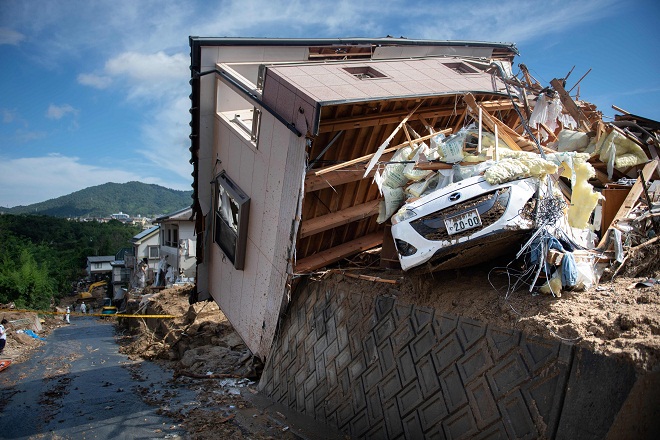Death Toll from Heavy Rain Hits Worst Level in Heisei Period
July 10, 2018
Tokyo- A total of 123 people have so far been confirmed dead in torrential rain that hit 12 prefectures mainly in western Japan over the weekend, local authorities and other sources said Monday.
The death toll reached the worst level from rain disasters in the Heisei period, which began on Jan. 8, 1989. The previous highest number of rain disaster victims including the missing was 98, recorded in October 2004 and again in August-September 2011, according to government data.
As many people are still unaccounted for, police officers, firefighters and Self-Defense Forces troops are continuing their search and rescue operations.
According to the Fire and Disaster Management Agency, evacuation orders or advisories had been issued to some 1.8 million people of 820,000 households in 14 of Japan's 47 prefectures as of 5:30 p.m. (8:30 a.m. GMT). About 11,200 people had been staying at evacuation centers in 15 prefectures.
Water supplies had been disrupted at 270,000 households as of 6 p.m., according to the Health, Labor and Welfare Ministry.
By prefecture, the number of deaths stood at 44 in Hiroshima, 36 in Okayama, 25 in Ehime, four in Kyoto, three each in Yamaguchi and Fukuoka, two each in Hyogo and Kagoshima and one each in Gifu, Shiga, Kochi and Saga.
A number of people still remained missing in Hiroshima, raising fears that the death toll will rise further.
The extent of damage in the Mabi district of Kurashiki, Okayama, has gradually become known since waters started to recede.
According to the Okayama prefectural government, 28 people have been confirmed dead in Mabi and a total of eight in other cities.
A landslide in the Ehime city of Uwajima killed two women and a nine-year-old boy. Three people also died in a house collapse due to a mudslide.
A 20-year-old man from Imari, Saga, was found dead on a shore in Matsuura, Nagasaki, after going missing.
On Monday morning, the Japanese government held the second meeting of an emergency task force set up in response to the downpour.
Prime Minister Shinzo Abe instructed the establishment of a team comprising vice minister-level officials from relevant government ministries and agencies to provide support to affected people promptly.
The new team, to be headed by Deputy Chief Cabinet Secretary Kazuhiro Sugita, will take measures to improve the environment at shelters, such as the installation of air conditioners, and supply relief goods to afflicted people.
Abe also met with Ehime Governor Tokihiro Nakamura at the prime minister's office in Tokyo.
"The central government will take fiscal measures so governments in afflicted regions can deal with the disasters without worries about funds," Abe said.
Nakamura called on the central government to continue relief assistance, designate the torrential rain as a disaster with extreme severity soon and expand the scope of the system to support postdisaster reconstruction of lives of affected people.
Meanwhile, Chief Cabinet Secretary Yoshihide Suga told a press conference the same day that 74,000 police officers and SDF personnel were engaged in search and rescue operations.
Suga also said that water and food supplies and bathing services have been provided in disaster-hit areas and installation of air conditioners has been under way at evacuation centers.
According to the transport ministry, train operations were disrupted on 32 lines of 10 operators, with 12 lines operated by West Japan Railway Co., including Geibi and Kure Lines, entirely closed. Jiji Press
Latest Videos
- THE UNTOLD STORY EXPERT INSIGHTS INTO THE UKRAINE
- NEGOTIATING A NEW ORDER US RUSSIA TALKS ON UKRAIN
- Ukraine: A Pawn in the Geopolitical Game? Will Trump Intervene?
- US VP VANCE CRITICIZES EUROPEAN DEMOCRACIES AT MUNICH SECURITY CONFERENCE
- UNCOVERING THE WEB OF DECEIT: CIA INFILTRATION OF THE MEDIA
- SHIFTING SANDS: TULSI GABBARD’S CONFIRMATION AND THE EVOLVING GLOBAL LANDSCAPE
- FAUCI SCANDAL: A THREAT TO GLOBAL HEALTH AND DEMOCRACY






